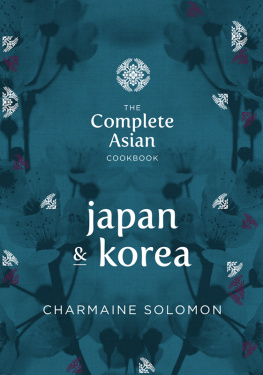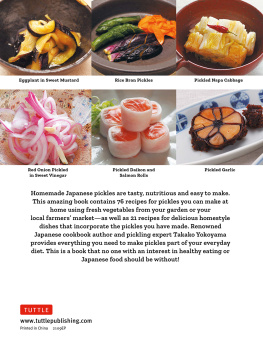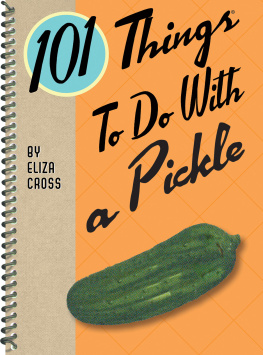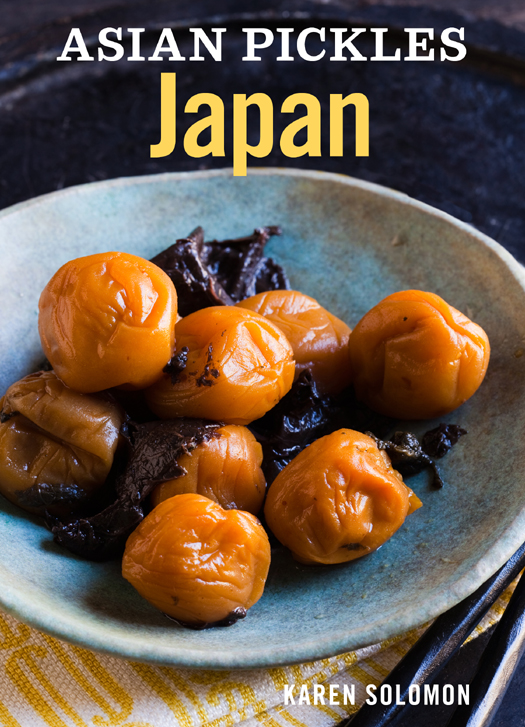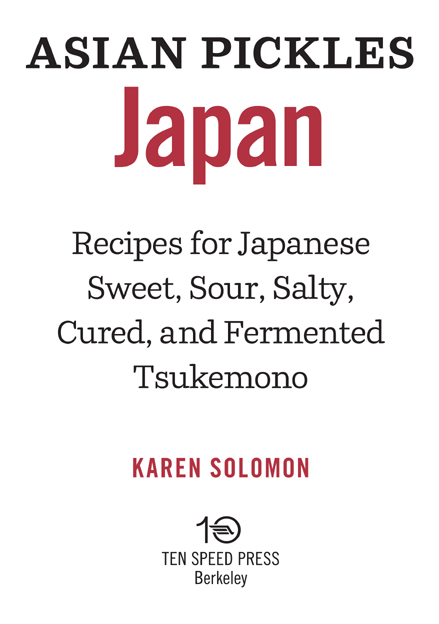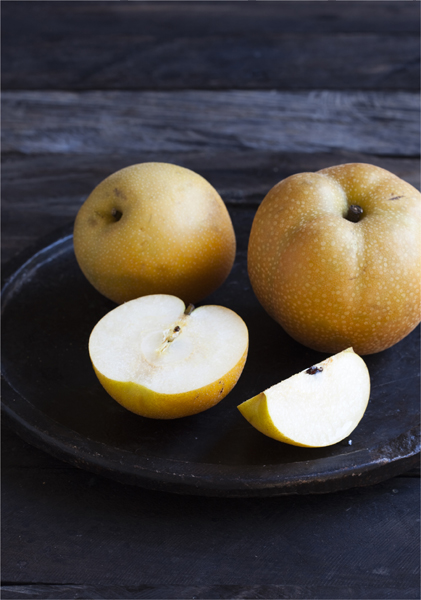Copyright 2012 by Karen Solomon
Photographs copyright 2012 by Jennifer Martin
All rights reserved.
Published in the United States by Ten Speed Press, an imprint of the Crown Publishing Group, a division of Random House, Inc., New York.
www.crownpublishing.com
www.tenspeed.com
Ten Speed Press and the Ten Speed Press colophon are registered trademarks of Random House, Inc.
eISBN: 978-1-60774-478-8
Enhanced edition eISBN 978-1-60774-518-1
Food styling by Karen Shinto
Prop styling by Christine Wolheim
v3.1
Other Cookbooks by Karen Solomon
Jam It, Pickle It, Cure It: And Other Cooking Projects
(available in hardcover)
Can It, Bottle It, Smoke It: And Other Kitchen Projects
(available in hardcover and wherever eBooks are sold)
FORTHCOMING EBOOKS IN THIS SERIES
Asian Pickles: Korea (March, 2013)
Asian Pickles: China (July, 2013)
Asian Pickles: India (November, 2013)
FORTHCOMING PRINT BOOK IN THIS SERIES
Asian Pickles: Japan, Korea, China, India, and Beyond (March, 2014)
VISIT WWW.KSOLOMON.COM FOR MORE INFORMATION
Contents
Introduction
Japanese pickles rock. Many of the flavors are quite familiar to those of us who regularly rally around sushi, ramen, and donburisoy sauce, ginger, the sweet quality of mirin cooking wineand these ingredients are regularly used in making many Japanese pickles. When I lived in Japan in the 1990s, I bought and gobbled pickles voraciously, and when a meal came to my table with that special little dish of colorful cut-up morsels, I was a happy woman.
So if you have grown bored of the classic bread and butters and dilly green beans, I am pleased to pull back the curtain on a plethora of new pickling possibilities. There are hundreds, if not thousands, of varieties of tsukemono (the Japanese word for pickled foods), many of which vary from region to region, or from home to home.
In no way is this a definitive guidethink of it more as a mix tape of a selection of my favorites: some my own kitchen creations, some classic, and all delicious and not overly labor-intensive. And unlike most tsukemono youll see on the grocery store shelf, these are all completely devoid of preservatives, artificial colors and flavorings, and other gunky stuff.
These recipes cover a lot of terrain. The first group of recipes are entirely traditional; the second batch are my pickled twists inspired by Japanese flavors and ingredients. Many can be crafted from ingredients found in any large grocery store; just a few will require a trip to a Japanese market. Some take weeks or months before you can taste your finished pickles; others are chopstick-ready in minutes. So if youre unable to hop the next jetliner or tramp steamer to Japan, you have many routes to transport yourself to the land of Japanese pickles.
Some of the flavors that are going to hit your tongue here are familiarlike the sweet, sharp, cleansing taste of gari, or cure. I hope that you dig the experience of exploring new and possibly challenging techniques and flavors as much as I do.
When and How to Serve Tsukemono
Im of the philosophy that pickles pair best with my mouth almost anytime, usually while Im standing in front of the open refrigerator. But if you must be a stickler, know that Japanese pickles are traditionally served on any number of occasions, including as part of breakfast or any light meal, with rice and soup; at the end of a meal, as they are believed to aid in digestion; or as happy hour snacks with sake, beer, or whiskey. Some dishes, like curries or fried pork, always have a pickled component served on the side of the plate (see (pickled plum)take that, coffee! In short, even traditionalists pretty much come around to the same conclusion as I do: there is never a bad moment to become one with a pickle.
On a well-laid Japanese table, pickles are presented quite artfully, with a lot of thought given to offering a variety of flavors, textures, and colors (which would explain why so many store-bought Japanese pickles come off the shelf in Kool-Aid shades of purple, pink, and yellow). Different styles of pickles are often combined; for example, pickles flavored variously with soy sauce, vinegar, and rice bran or miso will share a plate. It is common to see three or more varieties of pickles chopped into tiny bite-sized pieces and arranged side by side in a single small dish. This, my friend, is the pickle as art.
Basics of Japanese Pickling
While some picklers geek out on what gets pickled (insert your We can pickle that! Portlandia riff here), I find Im more interested in how in working with new pickling techniques and beds (see , below). If you share my brand of geekitude, then nothing can compare with Japanese pickles. Just a few pickling principles rule the tsukemono school:
.
2. Pressure. Another hallmark of tsukemono craft is the use of pressure. Ingredients to be pickled are salted, put in a container, and covered with a weighted drop lid that does not touch the edges of the container. The vegetables are slowly and gently compressed as they release their liquid and the lid lowers along with them, giving them a crunchy texture. (The resulting liquid is usually discarded, but some like to use it as a flavored, salty component in marinades.)
You can buy wooden drop lids (as well as pickling vessels) made especially for tsukemono, but this is not necessary. Any large bowl or bucket, or the insert of your slow cooker, or a clean large glass jar (even a fish bowl with a wide mouth) will work. The drop lid just needs to fit inside the containeryou could try a plate, the lid to a food storage container, a saucer for a flowerpot (clean and wrapped in plastic wrap), or a pot lid. (Note that one can purchase a spring-loaded pickling press, but they tend to exude a lot of pressureI have a flat batch of umeboshi to prove this point.) Weights placed atop a drop lid allow you, the pickle maker, a lot of control over the rate of the pickles compression. Again, special weights can be purchased, but why bother? Cans or bottles from your pantry, or even rocks, can be used: weigh them on a kitchen scale to find the object or combination of objects that will give you the weight designated in the recipe.
WHY YOU SHOULD RUN OUT RIGHT NOW AND BUY A KITCHEN SCALE
Dont have a kitchen scale? Go buy one. These days, a good one thats small enough to fit in a kitchen drawer is about $30. Youll find you will use it for much more than just weighing out vegetables and pressure weights for tsukemono: measuring ingredients for baking, making jam, estimating postage, and weighing your pet hamster. (Come on. You know you want to.)
3. Squeezing. This is another means of transformation for vegetables in Japanese pickling. The ingredients are first tossed with salt or some kind of salty medium (like soy sauce) to help draw out their water, left to rest for a bit, and then squeezed vigorously by hand. Squeezing is often used in conjunction with the pressure from a drop lid. In the recipes in this book that call for squeezing (, for example), it is important to really make your vegetables rain. Do not gently massage. Do not be a wimp. SQUEEZE without mercy. Added bonus: salty water makes your hands really soft. (Antibonus: it also irritates tiny cuts and hangnails. Ouch!)







